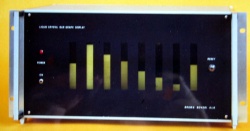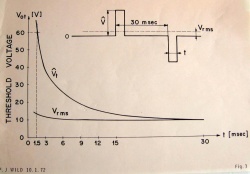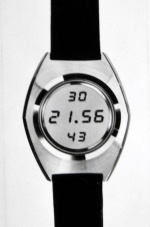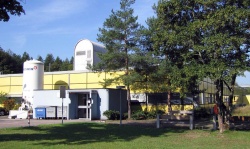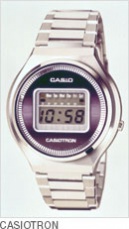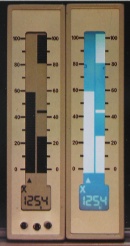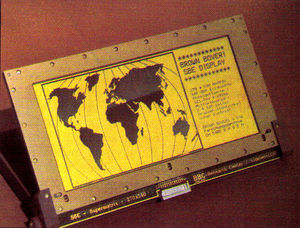First-Hand:Liquid Crystal Display Evolution - Swiss Contributions: Difference between revisions
| Line 72: | Line 72: | ||
== CASIO Computer Co., our major Japanese Customer == | == CASIO Computer Co., our major Japanese Customer == | ||
In addition to our Swiss wristwatch customers and Timex in the US, Casio Computer Co. became an important client in 1974. It is worthwhile to recall how this relationship evolved. I do not know how the initial contacts were established. BBC had a small subsidiary in Japan already. However, dealing with an important client in this new high-tech field meant that help was needed. In Japan, there are network organizations, where companies from different industries collaborate. These powerful associations are called [http://en.wikipedia.org/wiki/Keiretsu Keiretsu]. Many Keiretsu include at least one major bank and a major trading company <ref>M. L. Gerlach: "Alliance capitalism, The social organization of Japanese business," University of California Press, ISBN 0-520-07688-5, 1992.</ref>. When we wanted to work with OKI Electric Industry, the Fuyo Keiretsu got involved. I recall a meeting in Zurich with a representative of Marubeni, the corresponding trading company, and a visit of a top manager of the Yasuda group at the BBC Research Center.[[Image:Casiotron LCD Watch 1974.jpg|thumb|right|130x230px|TN LCD Wristwatch 1974]] The Japanese officer of OKI Electric from Germany, who was with us on that day, took a bow nearly to the ground when he greeted this influential man from the center of his Keiretsu. OKI Electric was interesting for us as a partner because they had a CMOS fab in Japan and were in line to become an LSI supplier for CASIO wristwatches. Casio planned to diversify into quartz watches, where similar components were needed as in electronic pocket calculators. After many discussions and the evaluation of our LCD samples, we were chosen to be the LCD supplier for the new wristwatches. On one occasion we had the honor of being invited for dinner at a typically Japanese restaurant in Tokyo by Mr. Kashio, one of the founding brothers. In 1974 our new factory for TN LCDs became operational. The [http://world.casio.com/corporate/history/chapter01/contents03/ ''' | In addition to our Swiss wristwatch customers and Timex in the US, Casio Computer Co. became an important client in 1974. It is worthwhile to recall how this relationship evolved. I do not know how the initial contacts were established. BBC had a small subsidiary in Japan already. However, dealing with an important client in this new high-tech field meant that help was needed. In Japan, there are network organizations, where companies from different industries collaborate. These powerful associations are called [http://en.wikipedia.org/wiki/Keiretsu Keiretsu]. Many Keiretsu include at least one major bank and a major trading company <ref>M. L. Gerlach: "Alliance capitalism, The social organization of Japanese business," University of California Press, ISBN 0-520-07688-5, 1992.</ref>. When we wanted to work with OKI Electric Industry, the Fuyo Keiretsu got involved. I recall a meeting in Zurich with a representative of Marubeni, the corresponding trading company, and a visit of a top manager of the Yasuda group at the BBC Research Center.[[Image:Casiotron LCD Watch 1974.jpg|thumb|right|130x230px|TN LCD Wristwatch 1974]] The Japanese officer of OKI Electric from Germany, who was with us on that day, took a bow nearly to the ground when he greeted this influential man from the center of his Keiretsu. OKI Electric was interesting for us as a partner because they had a CMOS fab in Japan and were in line to become an LSI supplier for CASIO wristwatches. Casio planned to diversify into quartz watches, where similar components were needed as in electronic pocket calculators. After many discussions and the evaluation of our LCD samples, we were chosen to be the LCD supplier for the new wristwatches. On one occasion we had the honor of being invited for dinner at a typically Japanese restaurant in Tokyo by Mr. Kashio, one of the founding brothers. In 1974 our new factory for TN LCDs became operational. The [http://world.casio.com/corporate/history/chapter01/contents03/ '''Casiotron digital wristwatch'''] with some interesting new features was released with our custom made LCD in October 1974. Not everything went smoothly. We encountered yield and delivery problems which required several trips to Tokyo to see Casio people. | ||
Due to price pressure and the fact that customers were mainly in Asia, BBC started an LCD assembly line in Hong Kong. I had to travel to HK to instruct local employees, first for final testing, then for doing custom designs. | Due to price pressure and the fact that customers were mainly in Asia, BBC started an LCD assembly line in Hong Kong. I had to travel to HK to instruct local employees, first for final testing, then for doing custom designs. | ||
Revision as of 16:50, 12 November 2012
contributed by Peter J. Wild, LM,
employed by BROWN, BOVERI & Cie (BBC), Switzerland, from 1969 to 1980
Introduction
It is commonly held that a team at the RCA David Sarnoff Research Center in Princeton, NJ under the leadership of Dr. George H. Heilmeier did the initial development of liquid crystal displays (LCDs), in particular of the Dynamic Scattering Mode (DSM) LCD.
In 2002, a comprehensive History of LCDs[1] was published containing a good amount of relevant information. However, the closeness of its author to the corresponding Japanese industry, in particular to Sharp Corporation, a major competitor of Casio Computer Co., and some "survivorship bias" concerning persons and institutions still engaged in LCD work, had an influence on the sources used.
Engineers might know that the Twisted Nematic (TN) LCD was invented at Hoffman-LaRoche in Basel, Switzerland[2]. TN LCDs replaced RCA's DSM LCDs within a few years time.
As the very first Member of Technical Staff doing work on LCDs at the Brown, Boveri Research Center in Baden, Switzerland, I have recently become personally motivated to give my account of less known events that took place while I was employed by BBC from 1969 to 1980. First, some personal background :
Education in Switzerland
I was born and raised in St. Gallen, a town in German speaking East Switzerland. During high school we had to learn French and English. I was better at mathematics and physics. I never imagined that I would end up marrying a girl from South America and speak first French and then Spanish with her !
In 1959 I started my studies in electrical engineering at the Swiss Federal Institute of Technology in Zurich (ETHZ). There were only two tracks to choose from at that time: power electrical engineering and what was called Schwachstromtechnik, which translated means low-current technology. This was basically an electronics curriculum and my preference. Part of the program was a mandatory internship in industry of at least half a year through which I was to gain some practical experience. I fulfilled this requirement as well as military service during my vacations. That way I did not have to sacrifice an entire year in order to accomplish the internship and military service, which is still compulsory for all Swiss men up to this day. In hindsight, my thesis was very much at the forefront of ultrasound medical instrumentation. My thesis partner and I had to develop the circuitry for a device to measure the flow in blood vessels with pulsed ultrasonic waves based on the Doppler effect. This work was done within the high frequency department of Prof. Fritz E. Borgnis. I graduated as Diplomingenieur at the end of 1963.
Work and Studies in the US
My mother had spent an entire year in California during the 1930's. These had been were very challenging times due to a long recession, and I remember her telling us a lot about her interesting experiences. Years later, she still maintained contact with friends in the US and, as a result, a family in Oregon became my sponsor to obtain a visa, when I moved to California looking for a job early in 1965. My poor English and limited experience made it difficult. I was subjected to all kinds of (for me) harrowing tests during interviews. I can recall specifically a written test that needed to be completed within a certain time limit with myself nervously watching the ticking clock. Also, my degree from the ETHZ (which ranks as the best university in continental Europe today) did not impress potential employers, as this excellent European university was hardly known in the US at that time.
Later that year, I joined Beckman Instruments in the East Bay across from San Francisco as a design engineer working on electronic measuring equipment. My choice had to do with the proximity of UC Berkeley, where I took extension classes in the evenings to improve my English and learn FORTRAN programming.
A colleague moved to Friden Research in Oakland, CA and asked me to join. Friden, Inc. had become a division of SINGER, the sewing machine company, in 1965. They offered me a full-time job with the privilege of attending graduate classes at UC Berkeley during working hours. Among other products, Friden (headquartered in San Leandro, CA) was well known for desktop calculators, the newest model EC-130 being already fully transistorized with a unique binary, serial memory using torsional wave propagation on a magnetic wire (magnetostrictive delay line).
A new facility for its research center was opened in the Stanford Industrial Park at Hillview Avenue in Palo Alto. I moved to Palo Alto and drove across the Bay Bridge to attend classes at Cal. While I was studying at Berkeley from 1966 to 1968, political student activities on the campus were in full bloom, but these were for me not more than a sideshow. At Friden I conceived a potential electronic replacement for the magnetic wire memory in the desktop electronic calculator. Transistors were relatively expensive. Therefore using flip-flops with two transistors to store bits was not an option. I proposed a type of dynamic shift register using basically one transistor and capacitor per stage in 1967. Unlike the concept of a "Bucket Brigade" for analog voltages as first published by Philips researchers in 1969 and later implemented as Charge-Coupled Devices, my circuit was intended to shift digital bit information in a serial memory. This is when I learned about the US custom of writing an invention report. It made me aware of the importance of patent notebooks and filings during my later work on LCDs (see section Patents).
Luckily, I could do my thesis at work choosing a topic of interest to both the company and my research adviser Prof. Martin Graham. This was an exemplary cooperation between university and industry already at that time! The name of my final report was "A Vector Generator for CRT Displays." I got the M.Sc. degree as a straight-A student, which gave me quite a feeling of satisfaction after my initial difficulties in the US. Now the doors were open. I got job offers from Bell Labs, Murray Hill, NJ, and the Singer Librascope Division in the Bay Area, but I decided to move back to Switzerland in 1968.
(Note: when SINGER / FRIDEN closed the Palo Alto facility in 1970, that building became the nucleus of the famous XEROX PARC !)
BROWN, BOVERI & Cie and its new Research Center in Switzerland
Brown, Boveri & Cie (BBC) was a traditional Swiss electrical engineering company founded by two immigrants in the 19th century. Their equipment and services for electric power generation and distribution as well as plant engineering for industries were well known and sold worldwide. A newer electronics division was active in process control, power semiconductors and telecommunications. The Swiss headquarters had difficulties managing the mighty German subsidiary which was much bigger than the Swiss operations. In order to strengthen R&D as well as underscore their local position, BBC opened a new research center based in Switzerland. Prof. Ambros P. Speiser was hired for this task. He had already founded and managed the IBM Zurich Research Center from 1956 to 1966, which had been the first research facility of IBM outside the US.
Operations at BBC Research started close to Baden in 1967. Talented people were hired rapidly, many with professional experience from the US. I was hired by Dr. F. K. von Willisen (who came from GE Labs, Schenectady, NY) in 1969. He was in charge of the Optics and Electronics Department. My first assignment was the development of a phase measurement[3] for an optoelectric current meter on high-voltage lines based on the Faraday effect working with Dr. André Jaecklin who came from Ampex in California.
Venture: BBC & ROCHE
In May 1969 BBC entered a formal cooperation with Hoffman-LaRoche (Roche) entitled "Medical Electronics," in which various common projects were studied, such as a new intensive care unit. I was asked by Dr. F. K. von Willisen to look into display technologies as part of the BBC side of the cooperation. On December 11th 1969 I gave an overview of state-of-the-art display technologies including RCA's work on LCDs at an internal BBC symposium. At the same venue Dr. Gerhard Meier of the Fraunhofer Institute in Freiburg, Germany, explained liquid crystals in detail. This institute already had a tradition of LC research. There was an exchange of staff and knowledge between this institute and a team at the Kent State University LC Institute, where Dr. Alfred Saupe and Dr. Juergen Nehring worked at the time.
In following with the conclusions of internal reports by both sides, LCD was established as a common research project. I became the very first person at BBC to work full time on LCDs, while Roche assigned organic chemists and hired additional physicists. ROCHE concentrated on the synthesis of LC substances suitable for LCDs and the physics of electrooptical effects in LC structures. BBC developed the corresponding cell technology, explored applications and driving electronics. It was a truly interdisciplinary effort. I set up a small team with a young electrical engineer and a couple of technical assistants to develop a suitable cell technology. We used a pyrolytic process to deposit metaloxyd transparent electrodes on glass substrates. The disadvantage of this approach was that edging of electrode patterns was difficult. It was exiting to work with our first LCDs exhibiting the Dynamic Scattering Mode (DSM) discovered by RCA. A common project with ROCHE called for patient monitoring to indicate crucial measurements as part of new life support equipment, so we studied bar graph displays. We found that we needed an array of several quasi-analog bar displays
side-by-side, which led us to study simple matrix displays. We certainly were among the first to study the limitations of matrix-addressed LCDs, and I disclosed some of the results at conferences later-on. In an experimental unit we connected a discrete capacitor in parallel to each LC segment and decoupled the segment with a diode from the driving electronics when not selected [4]. This is done today for active-matrix addressed LCDs using thin-film technology to integrate a transistor (TFT) and a storage capacitor at each pixel.
In the meantime Dr. Juergen Nehring, a physicist with a background in LC research, joined us in 1971. Together with him we published results for contrast enhancement in a special matrix display using a high-frequency quenching scheme [5].
Early on I did measurements of the electrooptic threshold voltage in LCDs. As a simple matrix LCD requires sequential addressing of rows (scanning, multiplexing) with a periodic refresh, pulsed voltages have to be applied to the
segments/pixels. In 1972, I found by varying the pulse width that the threshold, measured as RMS voltage, remains nearly constant [6]. More detailed analysis by others[7] referred to my discovery, which I presented at a conference in San Francisco, including the projection of a working LCD matrix mounted in a projection slide frame. An LCD matrix with high resolution was not yet possible, so we used a combination of a fixed image with the variable parts only implemented as LCD segments [8]. This was a very early predecessor of the present-day video projector connected to a computer.
A major milestone was the discovery of the 90-degree Twisted Nematic field effect (TN cell) and its properties by Dr. Wolfgang Helfrich and Dr. Martin Schadt, physicists at Roche. The corresponding patent application was filed on December 4th, 1970 (see section Patents). When new LC substances were developed for TN LCDs by chemists at ROCHE, we demonstrated the good cooperation by publishing the result together [9].
I probably did the first public demonstration of a working Twisted Nematic LCD, at least in Europe, at the IEE Conference on Displays organized by the University of Loughborough, UK, in September 1971. It was a transparent, quasi-analog bar TN LCD that I put on an overhead projector to show it to the audience. By varying the voltage applied, the bar moved up and down. It aroused much interest, and a I received a question from a participant about small, noticeably inhomogeneous areas, which were later identified as domains of reverse twist.
Unfortunately the common projects with Roche came to an end as early as March 1972. Roche had bought Electro-Médicine Dassault, France, which maintained some activities that were directly competing with some of the work at BBC (not related to LCDs). Our management considered this as a breach of confidence. Thereafter Roche became a supplier of LC substances to BBC. I played a role in evaluating Roche mixtures for our displays.
Manufacturing of LCDs by BBC
Early on Georges Keller, head of the electronic components division of BBC, became interested in LCDs. He provided the support of his glass technology experts at the tube division. Since initially we used a Schiff-base LC mixture for our TN displays, we had to hermetically seal our cells with glass frit bonding along the edges at high temperatures to avoid humidity entering the cell. This prevented us from using the common technique of orienting the LC molecules by rubbing an organic layer (a surfactant) on the glass surface. We employed a vacuum-deposited layer of SiO instead, where the structure for orientation is defined by the evaporation angle. The electrodes were manufactured with a new vacuum deposition process optimized by Balzers Ltd. in the neighboring Principality of Liechtenstein.
Prototype displays were made for a joint-effort wristwatch project that we did together with Ebauches SA, the major Swiss watch movements manufacturer and Faselec, the Swiss IC subsidiary of Philips. A working quartz digital wristwatch was shown at the MUBA fair in March 1973. It contained chips made by Faselec and our 8-digit TN LCD.
Georges Keller asked me to provide the technology part for a business plan to industrially manufacture LCDs. The main customers envisioned were wristwatch manufacturers. A pilot line was set up at the BBC tube factory in Birrfeld during 1973. Top management approved the business plan and credit to construct a brand new plant in Lenzburg. As far as I know, it was the first dedicated factory worldwide, built from scratch, measuring 39,000 square feet,
exclusively to manufacture TN LCDs in volume. ILIXCO had a small-scale operation in the US (comparable to a pilot line), and Sharp of Japan started with DSM LCDs for their calculators about at the same time. BBC built an additional LCD factory of 47,000 square feet in 1978.
Nobody knew in 1973 whether the new LCDs would have a sufficient operating life expectancy. I was charged to set up and supervise accelerated tests at elevated temperatures and voltages to get some clues. As a result, we improved our cell technology. I left the research center and joined the new LCD division in the capacity of deputy head to develop applications and manage part of the activities such as custom design of new LCDs, contacts with LC substance suppliers, IC manufacturers, testing and patent matters.
During the following years a lot of effort was needed to automate manufacturing. Labor costs in Switzerland were (and still are) high. The process chosen initially was not well suited for larger substrates and low-cost manufacturing. BBC was not any more willing to finance expansion in an area not important to its basic business. Therefore, a 50/50 joint venture was set up with Philips of The Netherlands at the beginning of 1980, called Videlec SA. Philips had a strong interest in display technologies for their consumer products, in particular the potential use of LCDs in TV sets.
CASIO Computer Co., our major Japanese Customer
In addition to our Swiss wristwatch customers and Timex in the US, Casio Computer Co. became an important client in 1974. It is worthwhile to recall how this relationship evolved. I do not know how the initial contacts were established. BBC had a small subsidiary in Japan already. However, dealing with an important client in this new high-tech field meant that help was needed. In Japan, there are network organizations, where companies from different industries collaborate. These powerful associations are called Keiretsu. Many Keiretsu include at least one major bank and a major trading company [10]. When we wanted to work with OKI Electric Industry, the Fuyo Keiretsu got involved. I recall a meeting in Zurich with a representative of Marubeni, the corresponding trading company, and a visit of a top manager of the Yasuda group at the BBC Research Center.
The Japanese officer of OKI Electric from Germany, who was with us on that day, took a bow nearly to the ground when he greeted this influential man from the center of his Keiretsu. OKI Electric was interesting for us as a partner because they had a CMOS fab in Japan and were in line to become an LSI supplier for CASIO wristwatches. Casio planned to diversify into quartz watches, where similar components were needed as in electronic pocket calculators. After many discussions and the evaluation of our LCD samples, we were chosen to be the LCD supplier for the new wristwatches. On one occasion we had the honor of being invited for dinner at a typically Japanese restaurant in Tokyo by Mr. Kashio, one of the founding brothers. In 1974 our new factory for TN LCDs became operational. The Casiotron digital wristwatch with some interesting new features was released with our custom made LCD in October 1974. Not everything went smoothly. We encountered yield and delivery problems which required several trips to Tokyo to see Casio people.
Due to price pressure and the fact that customers were mainly in Asia, BBC started an LCD assembly line in Hong Kong. I had to travel to HK to instruct local employees, first for final testing, then for doing custom designs.
Casio started manufacturing LCDs for more sophisticated applications (such as a pocket TV) on its own. Casio remains a major vendor of digital LCD wristwatches to this day.
Backlit LCDs
We probably were among the first to develop backlit TN LCDs. Since LCDs do not emit light themselves, they need ambient light or a dedicated light source for viewing. Wristwatches in particular cannot be read in the dark without some form of illumination. Therefore, at our laboratory we developed a suitable backlighting scheme, taking into account the limited space available in a wristwatch with a digital liquid crystal display. Our patented solution included a thin plastic diffuser plate behind the LCD with a miniature incandescent light bulb at its side[11]. This kind of arrangement is called edge-lit in present-day flatscreen LCD television sets using LEDs as light sources. The major difference
is that the backlight is continuously on during the operation of an LCD TV set, whereas in wristwatches the backlight is only used while pushing a button in order to save battery power. When enough ambient light is available, the display is used in its reflective mode.
A different solution was developed for panel-mounted meters that were proposed by BBC for power and industrial control centers. Reflective TN LCDs were conceived as bargraph replacements for conventional electromechanical meters, but were difficult to read under low ambient light, as they are mounted vertically. Therefore, we used a cold-cathode fluorescent lamp (CCFL) and a diffuser to backlight our bargraph display as shown on the right-hand side of the picture. This was much easier to read than the purely reflective type on the left.
Role of Patents
Prof. Ambros P. Speiser, Director of the BBC Research Center, encouraged his staff to file invention reports whenever appropriate. Our team came up with cell technology improvements and application ideas. Many patent applications were filed. The procedures in Switzerland, Germany and the US were different :
Switzerland. The Swiss authorities only examined strictly new developments in the watch and textile machine sectors. Otherwise patents were granted rather freely, but could be challenged later-on at a trial. When RCA defended their patent application with a broad claim for digital electronic wristwatches containing a battery, quartz crystal, frequency divider and LCD, I was asked by the BULOVA Watch Co. to testify against this claim. We showed that, based on the disclosed information, it was not possible to make a wristwatch with an adequate temperature range on the priority date. Therefore the patent was not granted in Switzerland.
Germany. The German patent authority had rules requiring publication of a patent application in the submitted form within 18 months as Offenlegungsschrift (laid open to public inspection). Many foreign applications were also filed in Germany within one year of filing in another country. This provided a good window to see what others were doing. After the examination by a German patent examiner, a revised Auslegeschrift, including claims allowed by the examiner, was published. Opponents could intervene within 3 months by introducing additional prior art or other facts until a definite patent (Patentschrift) was granted or rejected.
USA. In the US, the examination process is not public and the duration is unpredictable until a patent is granted and published. In addition, priority can be established before the filing date, if relevant patent notebook entries or other evidence can be presented by the inventor. This opportunity does not exist in Europe. A famous case was the invention of the twisted nematic, field effect LCD. ROCHE filed this patent application on December 4th, 1970 in Switzerland establishing thereby a priority. Dr. James Fergason followed more than four months later filing a similar patent application in the US on April 22nd, 1971. However, Fergason presented patent notebook entries, witnessed by colleagues, predating the priority date of ROCHE. In my opinion this gives unfair advantage to US filers.
At BBC we tracked the relevant patent publications of other organizations. In many cases I asked our patent department to oppose a particular German Auslegeschrift and provided earlier publications or patents to argue for more restricted claims or rejection.
For ROCHE as well as BBC (which after the merger with ASEA from Sweden in 1987 changed their name to ABB) royalty income from their LCD patents became a substantial source of income.
General Comments and events after my time at BBC
Working at the forefront of a new technology is exciting. I could attend many conferences, learned to make presentations and was invited to lecture on topics relating to my work on LCDs. Early recognition was evident in that I received invitations to make a presentation at UC BERKELEY and organize a panel discussion at the EPUL, Lausanne, in 1972. During several years I gave a lecture at the TECHNISCHE AKADEMIE ESSLINGEN near Stuttgart, Germany. As the only Swiss among many German lecturers, it was gratifying to get good ratings there by participants from industry.
Epilogue
I left BBC in 1980 to work in the field of telecommunications. In 1983 my former colleagues from the BBC Research Center invented the Super-Twisted Nematic LCD (STN-LCD), which made it possible to have good matrix displays with many pixels and reasonably high resolution for the first time [12]. STN LCDs were used in such products as the NINTENDO Game Boy, cellular phones, viewfinders of cameras, etc. I like to believe that this invention was a successful follow-up of our earlier focus on improving matrix addressing of LCDs. The corresponding patent brought in millions from licenses. Shortly thereafter VIDELEC in Lenzburg ceased operations, and the LC staff at the BBC Research Center was reduced to a skeleton.
ROCHE and BALZERS continued as suppliers to the LC industry for several years thereafter.
References
- ↑ H. Kawamoto: The history of liquid crystal displays, Proc. of the IEEE, vol. 90, no. 4, pp. 460-500, April 2002.
- ↑ M. Schadt, W. Helfrich: Voltage-dependent optical activity of a twisted nematic liquid crystal, Appl. Phys. Lett., vol. 18, no. 4, pp. 127-128, Feb. 1971.
- ↑ P. J. Wild: "A phasemeter for photoelectric measurement of magnetic fields," Review of Scientific Instruments, vol. 41, no. 8, pp. 1163-1167, August 1970.
- ↑ P. J. Wild, P. U. Schulthess: "Liquid crystal bar graph displays," Conference on Displays, IEE Conference Publication no. 80, pp. 161-164, Sept. 1971.
- ↑ P. J. Wild, J. Nehring: "Turn-on time reduction and contrast enhancement in matrix-addressed liquid-crystal light valves," Appl. Phys. Lett., vol. 19, no. 9, pp. 335-336, Nov. 1971.
- ↑ P. J. Wild: "Matrix-addressed liquid crystal projection display," Digest of Technical Papers, International Symposium, Society for Information Display, pp. 62–63, June 1972.
- ↑ P. M. Alt, P. Pleshko: "Scanning limitations of liquid-crystal displays," IEEE Trans. Electron Devices, vol. ED-21, no. 2, pp. 146–155, Feb. 1974.
- ↑ Patent US3895866: "Information-bearing devices and projection display systems therefor," filed Nov. 29, 1972, published July 22, 1975, inventors: A. de Quervain, P. Wild.
- ↑ A. Boller, H. Scherrer, M. Schadt, P. Wild: "Low electrooptic threshold in new liquid crystals," Proc. of the IEEE, vol. 60, no. 8, pp. 1002– 1003, Aug. 1972.
- ↑ M. L. Gerlach: "Alliance capitalism, The social organization of Japanese business," University of California Press, ISBN 0-520-07688-5, 1992.
- ↑ Patent US4096550: Illuminating arrangement for a field-effect liquid-crystal display as well as fabrication and application of the illuminating arrangement, filed Oct. 15, 1976, published June 20, 1978, inventors: W. Boller, M. Donati, J. Fingerle, P. Wild.
- ↑ T. J. Scheffer, J. Nehring: A new, highly multiplexable liquid crystal display, Appl. Phys. Lett., vol. 48, no. 10, pp. 1021–1023, Nov. 1984.
